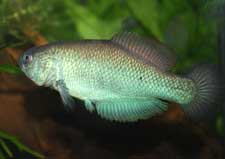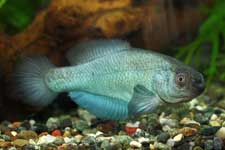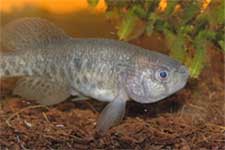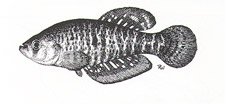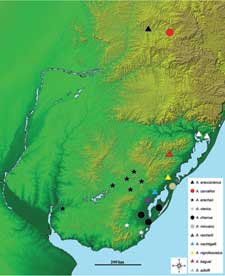This species was described originally in the genus Cynolebias.
Species of the genus Austrolebias were originally included in Cynolebias, that was described just five years earlier by the same author (Steindachner) from a single species, C. porosus from Pernambuco, northeastern Brazil (Steindachner, 1876). In the first phylogenetic analysis of Cyprinodontiformes, Parenti (1981) provided one synapomorphy to diagnose Cynolebias (caudal fin without scales) and synonymized this genus with several annual genera that had been described during the 20th century (Cynopoecilus Regan, 1912, Leptolebias Myers, 1952, Simpsonichthys, Carvalho, 1959, Campellolebias Vaz-Ferreira & Sierra, 1974, and Terranatos Taphorn & Thomerson, 1978). Costa's (1990) phylogenetic analysis of Rivulidae elevated Cynolebias sensu Parenti (1981) to a subfamily level, revalidated those genera previously synonymized, except Simpsonichthys, and rediagnosed Cynolebias based on five synapomorphies. Costa (1998), in a new phylogenetic analysis of Rivulidae, described Austrolebias and Megalebias Costa (both from La Plata and Patos Merin basins), including some species previously located in Cynolebias. Austrolebias was diagnosed by three synapomorphies and included species previously diagnosed as the "C. bellottii Steindachner" species complex (Costa, 1995); Megalebias was also diagnosed based on three synapomorphies and included species previously diagnosed as the "C. elongatus Steindachner" species complex (Costa, 1995). Cynolebias sensu stricto (diagnosed by three synapomorphies) included species previously diagnosed as the "C. porosus" species complex (Costa, 1995), distributed in northeastern Brazil. These three genera were included in the Subtribe Cynolebiatina with Austrolebias as the sister clade of Megalebias + Cynolebias (Costa, 1998). Costa (2002a), changed this relationship and proposed that Cynolebias was the sister genus of Austrolebias + Megalebias. Costa (2006b), considered Megalebias as a synonym of Austrolebias based on a morphological phylogenetic analysis in which Megalebias was nested within Austrolebias. Cynolebiatina was diagnosed by nine synapomorphies (Costa, 1998). However, as was mentioned before, Costa et al. (2017a), proposed Austrolebias as the sister genus of a clade with the following relationships: ((Cynolebias, Simpsonichthys), (Ophthalmolebias, Hypsolebias)).
Monophyly of Austrolebias is supported by three exclusive synapomorphies (Costa, 2006b): absence of scales between the corner of the mouth and anterior portion of the preopercular region and ventral portion of the opercular region, a deep urohyal (Fig. 2e), a dark gray to black infraorbital bar and supraorbital spot; and three synapomorphies independently arose in other cynolebiatines: males with dorsal and anal fins rounded, males with long urogenital papilla, and reduced ventral process of the anguloarticular.
However, according to relationships proposed by Costa et al. (2017a), these non-exclusive synapomorphies may represent plesiomorphic states of Cynolebiasini.
Costa (2008b), divided the genus Austrolebias in several subgenera according to the phylogenetic relationships obtained in Costa (2006b): Acantholebias Costa ((type species A. luteoflammulatus (Vaz-Ferreira, Sierra & Scaglia)), Acrolebias ((type species A. carvalhoi (Myers)), Argolebias ((type species A. nigripinnis (Regan); also known as the "A. alexandri" species group), Austrolebias (type species A. bellottii; includes "A. bellotti" + "A. adloffi" species groups), Cypholebias ((type species A. robustus (Günther)), Gymnolebias ((type species A. gymnoventris (Amato)), Megalebias ((type species A. wolterstorffi (Ahl)). According to a morphological phylogeny (Costa, 2010) the subgenus Argolebias could be paraphyletic. Relationships within Austrolebias are still unresolved; conflicting phylogenetic hypotheses have been proposed for this genus using morphological (Costa, 2006b, 2010; Loureiro, 2004) and molecular (mitochondrial) analyses (Garcia et al., 2014). Most subgeneric clades remain stable in species composition; however, relationships among clades and position of some species are still unresolved. In this study, we performed a phylogenetic analysis of Austrolebias sensu Costa (2006b), using the most complete species sampling to date and a total evidence approach, including morphological, and molecular (mitochondrial and nuclear) data.
A recent review of the family Rivulidae and a molecular and morphological phylogeny of the genus Austrolebias revealed the synonymy of A. vazferreirai with A. cinereus.
Remarks:
The above historycal line-up is taken from the 2018 Review paper by M. Loureiro et al. in which paper A. vazferreirrai is synonymized was till June 2023 A. cinereus.
Now:
Cypholebias cinereus (new combination)
Reproduction in general:
To breed most Austrolebias, you need a tank with about 10 to 25 liter water in it, a small jar or plastic container of about 10 to 15 cm high, a little bit of well-boiled peat moss, or coco-peat, and a water temperature between 18 and 24 C. It is wise to add a small filter to that tank and change the water regularly for 90 %. Bring one male and, if possible, two or more females in the tank and feed the fishes daily with live food like daphnia, red- and black mosquito larvae, and white worms. Austrolebias does not accept dry food quickly, and also, the prepared cow-heart is not preferred if live food is offered. If possible, breed this genus in larger tanks with more than one pair or trio and give some hiding places if you do so. When breeding with more than one male, you should also provide more than one spawning container. Every male must have one, and you will see they show interesting territorial behavior to attract females into their spawning place.
The male "flinders" around the female, displaying his fins high- up with the most intense colors. As the female is willing to spawn, she follows the male, pressing his head towards the layer of peat, and when the female contact the male's belly, both will dive into the peat layer. This layer should have a thickness of at least the length of the largest animal or, better, some deeper so they can dive entirely into it.
The spawning occurs during the whole fertile life of the fishes, starting at 5 to 6 weeks of age, till they become old and weak or die from the lack of water in their natural environment. This "end-of-life" will be within 8 to 11 months, depending on the temperature. Higher temperatures will trigger more rapid aging.
In the wild, Austrolebias live in colder environments during the wintertime. Temperatures in Uruguay, Paraguay, and Argentina can get very low. Incubation time usually is six weeks if stored at high temperatures ( 25 C.) and more extended if kept at lower temperatures. The development can last five to six months also. So it is wise to check the eggs regularly to see if the eyes inside the eggs are fully developed and the iris is well visible. When "eyed-up," put a part of the peat with the eggs in water at cool (ca. 18 C) temperature. If the fry usually hatches- and swims within a few hours, wet the rest of the peat. After hatching, feed the fry immediately with freshly born Artemia nauplii. A day or so later, I pour the water together with the fry off and place them in a well-filtered tank without any peat moss to grow up. Austrolebias are not used to strong currents, and juveniles can die if turbulence is too strong. The remaining peat will still have eggs inside that are not ready to hatch yet. Re-pack the peat and store it for some extra time. This hatching delay is nature's answer to short rain showers that fill pools only temporarily, followed by another dry period. Such an event would kill the entire population of the species in that area if all eggs were hatched with first rains. These (late) eggs will hatch later, sometimes very much later, and the fishes that were born earlier will eat these youngs.
As stated before, young's are growing fast and will produce their first eggs after 5 to 6 weeks already, if not even sooner. This breeding information applies to most Austrolebias. However, if the above Austrolebias- species have different behavior or extreme adult size, find these adaptions below in this chapter under <remarks>.
Remarks;
Variations
Map
Meristics
Dorsal 23.5,
Anal 25.0,
D/A 6
LL scale count (average) 32.0
Pre- dorsal length to % SL – 51.9 %
Depth to % SL – 34.7 %
Literature
Amato, L.H. 1986. Seis Especies nuevas del Genero Cynolebias Stdr. 1876, de Uruguay y Paraguay (Cyprinodontiformes, Rivulidae). Com. Zool. Mus. Hist. Nat. Montevideo, 11 (162): 9, pl. 6 (fig. 10).
Loureiro M., R. de Sá, S. W. Serra, F. Alonso, L. E. Krause Lanés, M. Vieira Volcan, P. Calviño, D. Nielsen, A. Duarte and G. Garcia. 2018. Review of the family Rivulidae (Cyprinodontiformes, Aplocheiloidei) and a molecular and morphological phylogeny of the annual fish genus Austrolebias Costa 1998. Neotropical Ichthyology, 16(3): e180007, 2018.
